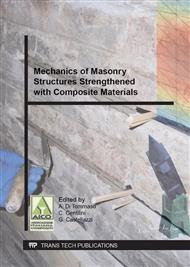p.139
p.147
p.155
p.163
p.170
p.178
p.189
p.197
p.205
In Situ Investigation of the Mechanical Strength of the Mortars: The Case of the Vaults of the Modena Cathedral
Abstract:
The 12th C. Modena Cathedral is a masterpiece testimony of early Romanesque architecture, artand civic values of the time. Following the inclusion in the UNESCO list in 1997, studies, surveysand maintenance works have started. The Emilia’s seismic events of May 2012 have happenedwhen the maintenance operations were already in an advanced phase. The quakes caused damageand re-opening of some historical cracks, in particular in the thin vaults of the naves, near thefaçade and at the junction between naves and choir and crypt. Fragments of brick, mortar from thejoints between bricks and even limited portions of a diagonal rib have fallen to the ground. In viewof seismic assessment and strengthening for improvement of the structural behaviour, detailedstudies of the vaults’ mortar became necessary. The investigation approach was minimal andpreservative, combining on-site close-up visual inspections and micro-destructive testing of themortar joints by mortar penetrometer. For this purpose, openings of 0.25x0.25 m2 in the renderlayer of the 23 vaults were created. The outcome has allowed differentiating between repair mortarsof different strength, used in different historic periods. The mortar resistance was very low butdifferent for lime mortar and gypsum. Values, divided in 3 classes of strength, were found tocorrelate well with the location and severity of the crack pattern and damage map in the vaults. Theresults were useful for a correct design (minimal and reversible) of the cathedral strengtheningintervention.
Info:
Periodical:
Pages:
170-177
Citation:
Online since:
September 2014
Authors:
Keywords:
Price:
Сopyright:
© 2015 Trans Tech Publications Ltd. All Rights Reserved
Share:
Citation:


